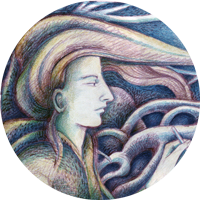Om mani padme hum.
I’m back from a dynamic trip to Nepal. A year or so back I wrote that I wanted mountains, I pictured myself half way up a hillside in sunshine, crystal clear air and sky, simple villages, … yaks perhaps? Well, I went in search of the picture and the state of mind. I didn’t quite find either, in fact it was rather different from how I expected it but very interesting all the same. Instead of finding peace and quiet, often the opposite was true and I found people everywhere. I came away very aware of my own unresolveable problems that won’t go away. I guess one always learns something unexpected. Anyway, here I shall share a few of my experiences.
 Our journey started with a stay in Boudhanath, one of the holiest Buddhist sites in Nepal. Here a giant stupa on top of a large white mandala dominates. It’s surrounded by a circle of buildings – mainly shops. Under the ever watchful, “Buddha eyes”, hordes of devoted Tibetans and many others circle the stupa in a clockwise direction spinning the prayer wheels as they go.
Our journey started with a stay in Boudhanath, one of the holiest Buddhist sites in Nepal. Here a giant stupa on top of a large white mandala dominates. It’s surrounded by a circle of buildings – mainly shops. Under the ever watchful, “Buddha eyes”, hordes of devoted Tibetans and many others circle the stupa in a clockwise direction spinning the prayer wheels as they go.
Often I’d find myself heading back to the guest house walking counter clockwise against the tide – slow progress. On top of the stupa, its quiet, with good views of the surrounding buildings and crowds, – monks talking, monks poised with their bowls awaiting food gifts, little Tibetan women with aprons and beads, pigeons, dogs, tourists with cameras, women with umbrellas against the sun. Busy, yes, but Boudhanath is inside a bubble, outside the gates it’s shocking with clamour and noise. It’s a sacred bubble despite the commercial side – the shops piping out new age chants, the shops selling gems, prayer flags, incense – the mandala seems to whisper and hum like some big inverted singing bowl.
And at dusk, out come the candles. The prayer wheels keep turning and the circling throng has grown; it’s religious rush hour at the stupa. The prayer flags keep flapping gently in the evening breeze. There’s something hypnotic about watching weathered prayer flags lapping softly at the air.
The Boudhanath stupa is interesting but not exactly beautiful to me. I find it somewhat comical like a square toy on top of a puff ball mushroom. I like circles though, I love the constant circular flow around it.
 Our guest house was next to one of many monasteries. Each morning we were woken very early by monks doing trumpet practice – on their “Rains Retreat”. Not far from Kathmandu airport, the explosion of planes overhead shook me in my semi-conscious state so I thought the world was coming to an end.
Our guest house was next to one of many monasteries. Each morning we were woken very early by monks doing trumpet practice – on their “Rains Retreat”. Not far from Kathmandu airport, the explosion of planes overhead shook me in my semi-conscious state so I thought the world was coming to an end.
Namaste,
Welcome to Nepal,
Om Mani Padme Hum.



 Kevin my partner, and I were on holiday in Guatemala. We had travelled north to visit the ancient Mayan ruins of Tikal. As well as being the largest and most famous Mayan site, Tikal is known for its extensive rainforest and abundant wildlife.
Kevin my partner, and I were on holiday in Guatemala. We had travelled north to visit the ancient Mayan ruins of Tikal. As well as being the largest and most famous Mayan site, Tikal is known for its extensive rainforest and abundant wildlife. I felt really keen to try and locate the howler group, as they sounded quite close by. But dusk was falling fast and the park was due to shut soon for the night, so we had to hurry.
I felt really keen to try and locate the howler group, as they sounded quite close by. But dusk was falling fast and the park was due to shut soon for the night, so we had to hurry. Suddenly a dispute broke out in the group. With shaking branches, grunting and squealing, a chaos of monkey drama unfolded above us. Startled, we backed away from the debris that rained down all around us. After a frantic chase, one monkey was left hanging from another, dangling precipitously.
Suddenly a dispute broke out in the group. With shaking branches, grunting and squealing, a chaos of monkey drama unfolded above us. Startled, we backed away from the debris that rained down all around us. After a frantic chase, one monkey was left hanging from another, dangling precipitously. Translating as best he could, Huglio explained that the vet would look for the mother. The guard thought that she would probably die and suggested that the pair were the unfortunate victims of a dispute or had been rejected by the group. What was the dispute about? Violence in Black Howler monkeys is uncommon, perhaps a newly dominant male was trying to commit infanticide.
Translating as best he could, Huglio explained that the vet would look for the mother. The guard thought that she would probably die and suggested that the pair were the unfortunate victims of a dispute or had been rejected by the group. What was the dispute about? Violence in Black Howler monkeys is uncommon, perhaps a newly dominant male was trying to commit infanticide.



